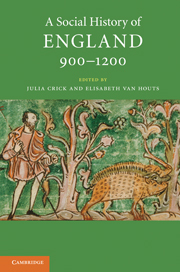Book contents
- Frontmatter
- Contents
- List of figures
- List of maps and tables
- List of contributors
- Acknowledgements
- List of abbreviations
- Map 1 England and its neighbours
- Map 2 England 900–1200
- I Introduction
- I.1 Land use and people
- I.2 Water and land
- I.3 Forest and upland
- I.4 Mineral resources
- I.5 Health and disease
- II.1 Authority and community
- II.2 Lordship and labour
- II.3 Order and justice
- II.4 War and violence
- II.5 Family, marriage, kinship
- II.6 Poor and powerless
- III.1 Towns and their hinterlands
- III.2 Commerce and markets
- III.3 Urban planning
- III.4 Urban populations and associations
- IV.1 Invasion and migration
- IV.2 Ethnicity and acculturation
- IV.3 Intermarriage
- IV.4 The Jews
- V.1 Religion and belief
- V.2 Rites of passage and pastoral care
- V.3 Saints and cults
- V.4 Public spectacle
- V.5 Textual communities (Latin)
- V.6 Textual communities (vernacular)
- VI.1 Learning and training
- VI.2 Information and its retrieval
- VI.3 Esoteric knowledge
- VI.4 Medical practice and theory
- VI.5 Subversion
- Glossary
- Time line 900–1200
- Further reading
- Index
II.3 - Order and justice
Published online by Cambridge University Press: 05 June 2012
- Frontmatter
- Contents
- List of figures
- List of maps and tables
- List of contributors
- Acknowledgements
- List of abbreviations
- Map 1 England and its neighbours
- Map 2 England 900–1200
- I Introduction
- I.1 Land use and people
- I.2 Water and land
- I.3 Forest and upland
- I.4 Mineral resources
- I.5 Health and disease
- II.1 Authority and community
- II.2 Lordship and labour
- II.3 Order and justice
- II.4 War and violence
- II.5 Family, marriage, kinship
- II.6 Poor and powerless
- III.1 Towns and their hinterlands
- III.2 Commerce and markets
- III.3 Urban planning
- III.4 Urban populations and associations
- IV.1 Invasion and migration
- IV.2 Ethnicity and acculturation
- IV.3 Intermarriage
- IV.4 The Jews
- V.1 Religion and belief
- V.2 Rites of passage and pastoral care
- V.3 Saints and cults
- V.4 Public spectacle
- V.5 Textual communities (Latin)
- V.6 Textual communities (vernacular)
- VI.1 Learning and training
- VI.2 Information and its retrieval
- VI.3 Esoteric knowledge
- VI.4 Medical practice and theory
- VI.5 Subversion
- Glossary
- Time line 900–1200
- Further reading
- Index
Summary
THE PROBLEM OF DISORDER
According to Richard fitz Nigel, the royal treasurer, writing in the late 1170s,
because of the innumerable riches of this kingdom, and also because of the natives' innate tendency to drunkenness which is always accompanied by lust, theft often occurs either openly or secretly, and also homicides and other sorts of crime; and the criminals are egged on by loose women, so that there is nothing that they will not dare or attempt when they listen to their counsels.
This diagnosis receives support from anecdotal evidence, for example from a near-contemporary story recounted by hagiographers of Thomas Becket. A peasant named Ailward lived on the royal manor of Westoning in Bedfordshire. His neighbour owed him a penny for ploughing that Ailward had performed, but the neighbour refused to pay, claiming that he could not afford it. However, he did have enough money to go to the tavern. The writer points out that ‘it was the custom of the English on feast days to indulge in banqueting and getting drunk, and to watch their enemies and mock their observance of the holy days’. Still the neighbour refused to pay the debt, even when Ailward demanded only half of it, allowing them each to spend a halfpenny on drinking. Ailward then took matters into his own hands. He broke into his neighbour's house and seized various goods, including a whetstone. These goods, we are told, were barely worth a penny.
- Type
- Chapter
- Information
- A Social History of England, 900–1200 , pp. 115 - 123Publisher: Cambridge University PressPrint publication year: 2011

